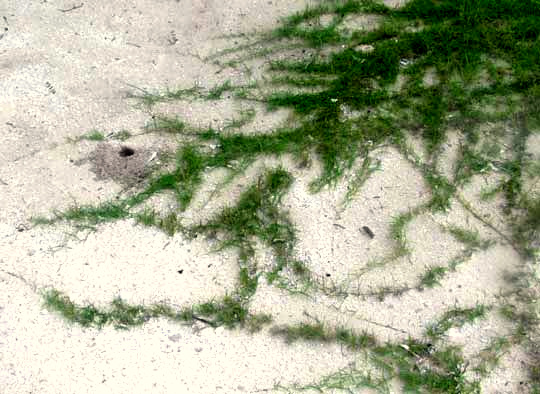Excerpts from Jim Conrad's
Naturalist Newsletter

from the September 4, 2011 Newsletter issued from Mayan Beach Garden Inn 20 kms north of Mahahual; Caribbean coastal beach and mangroves, ~N18.89°, ~W87.64°, Quintana Roo state, MÉXICO
A BEACH-STABILIZING GRASS
Hurricane Dean in 2007 was the third-most powerful of all Atlantic hurricanes to make landfall since records began to be kept. Its eye came ashore between here and Mahahual 20kms to the south. One day soon afterwards Marcia was surveying the damage near where the eye passed and noticed something interesting: A certain little mat-forming grass had done an amazing job protecting the beach from Dean's erosion.
Marcia dug up some of the grass and took it back to her place, to help protect her own beach from erosion. You can see what became of her planting in a shot of one of her palapas with grass-covered sand behind it at the top of this page. Notice how much higher the sand is beneath the grass than where the sand is unprotected.
At the grassy area's edge creeping rhizomes snake across bare sand capturing windblown sandgrains, building up the surface and stabilizing it, as seen below:

At first I had no idea what grass this was. However, now it's flowering and I can identify it. Close-ups of two inflorescence spikes, with the one on the right showing a zigzag rachis distinctive of the rye-grass-related group of grasses it belongs to below:

Finally, you can see the plant's much-branching, wiry rhizomes, its narrow, in-folding (" involute"), sharp- pointed leaves and stiff, spikelike flowering heads below:

It's a zoysia grass! Zoysia grasses are these grasses you see advertised under the "never-mow-again" heading. Originally from Asia, they form a dense, low carpet that never gets too shaggy. I've known about zoysia grasses for many years, but I've always associated them with moist or generously watered environments. I never dreamed that a zoysia grass could do so well in this hot, sandy, salt-sprayed beach environment.
From what I can see on the Internet, most garden centers in North America speak of zoysia grass as if it were one thing. In fact there are at least three different species of the genus Zoysia commonly sold in the US, plus there are numerous cultivars with names like Manila Grass, Japanese Lawngrass, Belaire Zoysia Grass, etc. Zoysia grasses in general have had their genes well scrambled by horticulturists. Not only have the boundaries between species been blurred, but even closely related grass genera have contributed genes to the mix.
Therefore, beyond calling Marcia's grass zoysia grass, I can't say exactly which kind it is. Of the three common species sold in the US, ZOYSIA TENUIFOLIA, or "Mascarene-Grass," looks most like ours because of its stiff, short, sharp-pointed, " involute" blades. Most zoysia grasses I've seen produce softer, flatter, blunter blades, though maybe our plants are wirier because of their especially hot, dry environment. Also, Zoysia tenuifolia is known to be widely used throughout the Caribbean Basin, though it is native to Japan. A fair overview of the Zoysia kinds appears here.
Marcia mentions one further attraction of her zoysia grass: Some neighbors stabilizing their sand with St. Augustine Grass have problems with mosquitoes breeding in the grass. That doesn't happen with her zoysia grass.